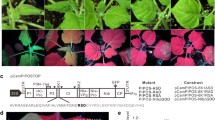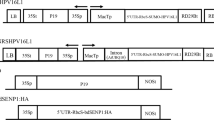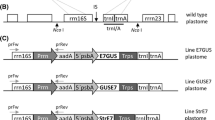Abstract
Chloroplast genetic engineering has long been recognised as a powerful technology to produce recombinant proteins. To date, however, little attention has been given to the causes of pleiotropic effects reported, in some cases, as consequence of the expression of foreign proteins in transgenic plastids. In this study, we investigated the phenotypic alterations observed in transplastomic tobacco plants accumulating the Pr55gag polyprotein of human immunodeficiency virus (HIV-1). The expression of Pr55gag at high levels in the tobacco plastome leads to a lethal phenotype of seedlings grown in soil, severe impairment of plastid development and photosynthetic activity, with chloroplasts largely resembling undeveloped proplastids. These alterations are associated to the binding of Pr55gag to thylakoids. During particle assembly in HIV-1 infected human cells, the binding of Pr55gag to a specific lipid [phosphatidylinositol-(4-5) bisphosphate] in the plasma membrane is mediated by myristoylation at the amino-terminus and the so-called highly basic region (HBR). Surprisingly, the non-myristoylated Pr55gag expressed in tobacco plastids was likely able, through the HBR motif, to bind to nonphosphorous glycerogalactolipids or other classes of lipids present in plastidial membranes. Although secondary consequences of disturbed chloroplast biogenesis on expression of nuclear-encoded plastid proteins cannot be ruled out, results of proteomic analyses suggest that their altered accumulation could be due to retrograde control in which chloroplasts relay their status to the nucleus for fine-tuning of gene expression.





Similar content being viewed by others
References
Amthor JS (2000) The McCree-de Wit-Penning de Vries-Thornley respiration paradigms: 30 years later. Ann Bot 86:1–20
Asakura Y, Kikuchi S, Nakai M (2008) Non-identical contributions of two membrane-bound cpSRP components, cpFtsY and Alb3, to thylakoid biogenesis. Plant J 56:1007–1017
Baker NR (2008) Chlorophyll fluorescence: a probe of photosynthesis in vivo. Annu Rev Plant Biol 59:89–113
Bally J, Job C, Belghazi M, Job D (2011) Metabolic adaptation in transplastomic plants massively accumulating recombinant proteins. PLoS One 6:e25289
Beeler S, Liu HC, Stadler M, Schreier T, Eicke S, Lue WL, Truernit E, Zeeman SC, Chen J, Kotting O (2014) Plastidial NAD-dependent malate dehydrogenase is critical for embryo development and heterotrophic metabolism in Arabidopsis. Plant Physiol 164:1175–1190
Bock R, Warzecha H (2010) Solar-powered factories for new vaccines and antibiotics. Trends Biotechnol 28:246–252
Bollenbach TJ, Tatman DA, Stern DB (2003) CSP41a, a multifunctional RNA-binding protein, initiates mRNA turnover in tobacco chloroplasts. Plant J 36:842–852
Brestic M, Zivcak M, Olsovska K, Shao HB, Kalaji HM, Allakhverdiev SI (2014) Reduced glutamine synthetase activity plays a role in control of photosynthetic responses to high light in barley leaves. Plant Physiol Biochem 57:93–105
Cardi T, Lenzi P, Maliga P (2010) Chloroplasts as expression platforms for plant-produced vaccines. Expert Rev Vaccines 9:893–911
Chateigner-Boutin AL, Ramos-Vega M, Guevara-Garcia A, Andres C, de la Luz Gutierrez-Nava M, Cantero A, Delannoy E, Jimenez LF, Lurin C, Small I, Leon P (2008) CLB19, a pentatricopeptide repeat protein required for editing of rpoA and clpP chloroplast transcripts. Plant J 56:590–602
Chen L-S, Cheng L (2004) CO2 assimilation, carbohydrate metabolism, xanthophyll cycle, and the antioxidant system of ‘Honeycrisp’ apple leaves with zonal chlorosis. J Amer Soc Hort Sci 129:729–737
Chen L-S, Cheng L (2010) The acceptor side of photosystem II is damaged more severely than the donor side of photosystem II in ‘Honeycrisp’ apple leaves with zonal chlorosis. Acta Physiol Plant 32:253–261
Chi W, Ma J, Zhang D, Guo J, Chen F, Lu C, Zhang L (2008) The pentratricopeptide repeat protein DELAYED GREENING1 is involved in the regulation of early chloroplast development and chloroplast gene expression in Arabidopsis. Plant Physiol 147:573–584
Chukkapalli V, Ono A (2011) Molecular determinants that regulate plasma membrane association of HIV-1 Gag. J Mol Biol 410:512–524
Cornic G, Briantais JM (1991) Partitioning of photosynthetic electron flow between CO2 and O2 reduction in a C3 leaf (Phaseolus vulgaris L.) at different CO2 concentrations and during drought stress. Planta 183:178–184
Demarsy E, Courtois F, Azevedo J, Buhot L, Lerbs-Mache S (2006) Building up of the plastid transcriptional machinery during germination and early plant development. Plant Physiol 142:993–1003
Demmig-Adams B, Adams WW III (2006) Photoprotection in an ecological context: the remarkable complexity of thermal energy dissipation. New Phytol 172:11–21
Genty B, Briantais J-M, Baker NR (1989) The relationship between the quantum yield of photosynthetic electron transport and quenching of chlorophyll fluorescence. Biochim Biophys Acta 990:87–92
Giorio P (2011) Black leaf-clips increased minimum fluorescence emission in clipped leaves exposed to high solar radiation during dark adaptation. Photosynthetica 49:371–379
Gutierrez-Nava MdL, Gillmor CS, Jimenez LF, Guevara-Garcia A, Leon P (2004) CHLOROPLAST BIOGENESIS genes act cell and noncell autonomously in early chloroplast development. Plant Physiol 135:471–482
Hennig A, Bonfig K, Roitsch T, Warzecha H (2007) Expression of the recombinant bacterial outer surface protein A in tobacco chloroplasts leads to thylakoid localization and loss of photosynthesis. FEBS J 274:5749–5758
Huang X, Zhang X, Yang S (2009) A novel chloroplast-localized protein EMB1303 is required for chloroplast development in Arabidopsis. Cell Res 19:1205–1216
Jarvis P, Lopez-Juez E (2013) Biogenesis and homeostasis of chloroplasts and other plastids. Nat Rev Mol Cell Biol 14:787–802
Kahlau S, Bock R (2008) Plastid transcriptomics and translatomics of tomato fruit development and chloroplast-to-chromoplast differentiation: chromoplast gene expression largely serves the production of a single protein. Plant Cell 20:856–874
Kessans SA, Linhart MD, Matoba N, Mor T (2013) Biological and biochemical characterization of HIV-1 Gag/dgp41 virus-like particles expressed in Nicotiana benthamiana. Plant Biotechnol J 11:681–690
Kobayashi K, Nakamura Y, Ohta H (2009) Type A and type B monogalactosyldiacylglycerol synthases are spatially and functionally separated in the plastids of higher plants. Plant Physiol Biochem 47:518–525
Kozaki A, Takeba G (1996) Photorespiration protects C3 plants from photooxidation. Nature 384:557–560
Kuroda H, Maliga P (2002) Overexpression of the clpP 5′-untranslated region in a chimeric context causes a mutant phenotype, suggesting competition for a clpP-specific RNA maturation factor in tobacco chloroplasts. Plant Physiol 129:1600–1606
Kwon KC, Cho MH (2008) Deletion of the chloroplast-localized AtTerC gene product in Arabidopsis thaliana leads to loss of the thylakoid membrane and to seedling lethality. Plant J 55:428–442
Lichtenthaler HK (1987) Chlorophylls and carotenoids: pigments of photosynthetic biomembranes. Methods Enzymol 148:350–382
Li-Cor (2011) Using the Li-6400/Li-6400XT portable photosynthesis system. Lincoln, NE, USA
Lössl AG, Waheed MT (2011) Chloroplast-derived vaccines against human diseases: achievements, challenges and scopes. Plant Biotechnol J 9:527–539
Maliga P, Bock R (2011) Plastid biotechnology: food, fuel, and medicine for the 21st century. Plant Physiol 155:1501–1510
Martelli GP, Russo M (1984) Use of thin sectioning for visualization and identification of plant viruses. Methods Virol 8:143–224
McCabe MS, Klaas M, Gonzalez-Rabade N, Poage M, Badillo-Corona JA, Zhou F, Karcher D, Bock R, Gray JC, Dix PJ (2008) Plastid transformation of high-biomass tobacco variety Maryland Mammoth for production of human immunodeficiency virus type 1 (HIV-1) p24 antigen. Plant Biotechnol J 6:914–929
Meyers A, Chakauya E, Shephard E, Tanzer FL, Maclean J, Lynch A, Williamson AL, Rybicki EP (2008) Expression of HIV-1 antigens in plants as potential subunit vaccines. BMC Biotechnol 8:53
Motohashi R, Yamazaki T, Myouga F, Ito T, Ito K, Satou M, Kobayashi M, Nagata N, Yoshida S, Nagashima A, Tanaka K, Takahashi S, Shinozaki K (2007) Chloroplast ribosome release factor 1 (AtcpRF1) is essential for chloroplast development. Plant Mol Biol 64:481–497
Mudd EA, Sullivan S, Gisby MF, Mironov A, Kwon CS, Chung WI, Day A (2008) A 125 kDa RNase E/G-like protein is present in plastids and is essential for chloroplast development and autotrophic growth in Arabidopsis. J Exp Bot 59:2597–2610
Oey M, Lohse M, Kreikemeyer B, Bock R (2009) Exhaustion of the chloroplast protein synthesis capacity by massive expression of a highly stable protein antibiotic. Plant J 57:436–445
Paddock T, Lima D, Mason ME, Apel K, Armstrong GA (2012) Arabidopsis light-dependent protochlorophyllide oxidoreductase A (PORA) is essential for normal plant growth and development. Plant Mol Biol 78:447–460
Parry MA, Keys AJ, Madgwick PJ, Carmo-Silva AE, Andralojc PJ (2008) Rubisco regulation: a role for inhibitors. J Exp Bot 59:1569–1580
Portis AR Jr (2003) Rubisco activase–Rubisco’s catalytic chaperone. Photosynth Res 75:11–27
Rabilloud T, Strub JM, Luche S, van Dorsselaer A, Lunardi J (2001) A comparison between Sypro Ruby and ruthenium II tris (bathophenanthroline disulfonate) as fluorescent stains for protein detection in gels. Proteomics 1:699–704
Rigano MM, Scotti N, Cardi T (2012) Unsolved problems in plastid transformation. Bioengineered 3:329–333
Ruhlman T, Verma D, Samson N, Daniell H (2010) The role of heterologous chloroplast sequence elements in transgene integration and expression. Plant Physiol 152:2088–2104
Salvi D, Rolland N, Joyard J, Ferro M (2008) Purification and proteomic analysis of chloroplasts and their sub-organellar compartments. Methods Mol Biol 432:19–36
Scotti N, Cardi T (2014) Transgene-induced pleiotropic effects in transplastomic plants. Biotechnol Lett 36:229–239
Scotti N, Alagna F, Ferraiolo E, Formisano G, Sannino L, Buonaguro L, De Stradis A, Vitale A, Monti L, Grillo S, Buonaguro F, Cardi T (2009) High-level expression of the HIV-1 Pr55gag polyprotein in transgenic tobacco chloroplasts. Planta 229:1109–1122
Scotti N, Rigano MM, Cardi T (2012) Production of foreign proteins using plastid transformation. Biotechnol Adv 30:387–397
Scotti N, Bellucci M, Cardi T (2013) The chloroplasts as platform for recombinant proteins production. In: Duchéne A-M (ed) Translation in mitochondria and other organelles. Springer, Berlin Heidelberg, pp 225–262
Srivastava A, Strasser RJ, Govindjee (1999) Greening of peas: parallel measurements of 77 K emission spectra, OJIP chlorophyll a fluorescence transient, period four oscillation of the initial fluorescence level, delayed light emission, and P700. Photosynthetica 37:365–392
Strasser RJ, Srivastava A, Tsimilli-Michael M (2000) The fluorescence transient as a tool to characterize and screen photosynthetic samples. In: Yunus M, Pathre U, Mohanty P (eds) Probing photosynthesis: mechanism regulation and adaptation. Taylor and Francis, London, pp 443–480
Tseng CC, Sung TY, Li YC, Hsu SJ, Lin CL, Hsieh MH (2010) Editing of accD and ndhF chloroplast transcripts is partially affected in the Arabidopsis vanilla cream1 mutant. Plant Mol Biol 73:309–323
Valentini R, Epron D, De Angelis P, Matteucci G, Dreyer E (1995) In situ estimation of net CO2 assimilation, photosynthetic electron flow and photorespiration in Turkey oak (Q. cerris L.) leaves: diurnal cycles under different levels of water supply. Plant Cell Environ 18:631–640
von Caemmerer S, Farquhar GD (1981) Some relationships between the biochemistry of photosynthesis and the gas exchange of leaves. Planta 153:376–387
Yu QB, Jiang Y, Chong K, Yang ZN (2009) AtECB2, a pentatricopeptide repeat protein, is required for chloroplast transcript accD RNA editing and early chloroplast biogenesis in Arabidopsis thaliana. Plant J 59:1011–1023
Zhou F, Badillo-Corona JA, Karcher D, Gonzalez-Rabade N, Piepenburg K, Borchers AM, Maloney AP, Kavanagh TA, Gray JC, Bock R (2008) High-level expression of human immunodeficiency virus antigens from the tobacco and tomato plastid genomes. Plant Biotechnol J 6:897–913
Acknowledgments
This work was partially funded by a grant from the Italian Ministry of Research (MIUR; DD 1105/2002) to TC, and by a CNR Short-Term Mobility grant to NS. Assistance of Mr. G. Guarino with artwork and Mr. R. Nocerino (CNR-IBBR, Portici, Italy) with plant growth are gratefully acknowledged. We also thank Dr. S. Grillo (CNR-IBBR, Portici Italy) and Dr. A. Maggio (University of Naples ‘Federico II’, Italy) for the critical review of the manuscript. HIV-1 antisera (specific to the p24 and p17 subunits) were provided by the NIBSC Centralized Facility for AIDS reagent (EU Programme EVA, UK Medical Research Council).
Author information
Authors and Affiliations
Corresponding author
Electronic supplementary material
Below is the link to the electronic supplementary material.
Rights and permissions
About this article
Cite this article
Scotti, N., Sannino, L., Idoine, A. et al. The HIV-1 Pr55gag polyprotein binds to plastidial membranes and leads to severe impairment of chloroplast biogenesis and seedling lethality in transplastomic tobacco plants. Transgenic Res 24, 319–331 (2015). https://doi.org/10.1007/s11248-014-9845-5
Received:
Accepted:
Published:
Issue Date:
DOI: https://doi.org/10.1007/s11248-014-9845-5




